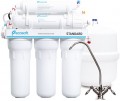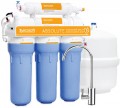Stages of purification
The number of purification stages provided for in the filter design. At each stage, water passes through its own filter element, clearing itself of certain contaminants; in this case, the steps are arranged in order from coarser cleaning to finer. For example,
a three-stage system may look like this: the first stage is mechanical removal of impurities, the second stage is the removal of ferrous, and the third is filtration through a carbon cartridge.
The more stages of purification — the more advanced the filter is considered, the cleaner water it usually provides at the outlet. Accordingly, this moment largely depends on the purpose (see “Type”): for example, multi-stage filtration is quite rare in main models, it is practically not used at all in pre-filters, but the number of stages can reach 9 in models for sink.
Pollution clipping
The smallest size of foreign particles (in microns) that the filter can hold in total. Accordingly, the smaller this size, the higher the filtration efficiency, the less undissolved impurities remain in the filtered water. On the other hand, finer cleaning usually takes more time, which affects the speed (throughput) of the filter. It should be noted that in the case of using reverse osmosis filters, the filtration is very fine, up to 0.01 microns.
Water mineralization
The presence of a
water mineralizer in the filter design. The mineralizer is usually a container filled with a special slowly dissolving mixture. Thanks to it, filtered water is saturated with various micronutrients: calcium, potassium, fluorine, ferrous (of course, not harmful colloidal ferrous, but another easily digestible form) and others. They have a positive effect on the human body and improve the taste of the water itself compared to completely purified water.
Mineralizers are found mainly in filters equipped with reverse osmosis systems (see above): the fact is that during the operation of such systems, not only harmful impurities are removed from the water, but also the mentioned micronutrients that got there naturally.
Tank
Availability of a
tank in the reverse osmosis system. It provides a convenient and necessary reserve of clean water (since the filtration process itself is slow) and is installed after the membrane, before the final purification stage (post-filter). Inside the tank, there is a pressurized air compartment that allows water to be displaced when the faucet is opened. That is why the useful volume of the tank is less than the total volume, which we indicate.
The volume (size) of the reverse osmosis tank is selected based on needs and available space. The most common option is
12 liters, suitable for a family of 3–4 people.

